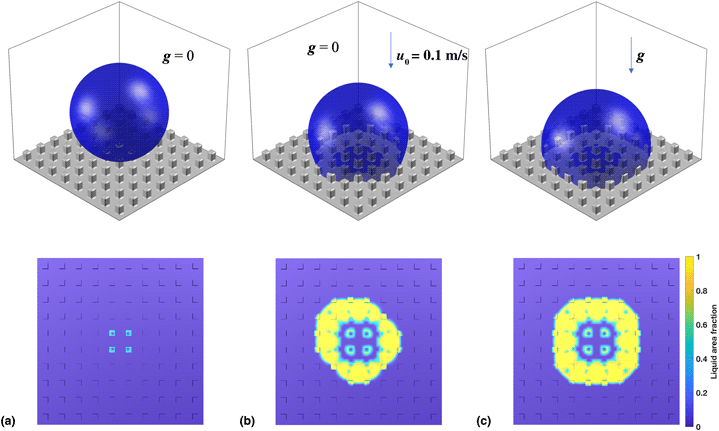Article contents
Effect of gravity in the Cassie-to-Wenzel transition on a micropatterned surface
Published online by Cambridge University Press: 13 December 2019
Abstract

When the Cassie–Baxter and Wenzel states coexist for a liquid droplet on a micropatterned surface, the Cassie-to-Wenzel transition takes place if the energy barrier is overcome. Although multiple metastable states coexist due to the micropattern, this paper presents a simple Cassie-to-Wenzel transition of a 2 µL water droplet on a particular micropillared surface: When the droplet is gently deposited above the surface, it equalizes to the Cassie state at zero gravity; however, it transitions to the Wenzel state at the terrestrial gravity, in which the gravitational potential energy overcomes the energy barrier between the Cassie and Wenzel states.
Information
- Type
- Research Letters
- Information
- Copyright
- Copyright © Materials Research Society 2019
References
1.Wenzel, R.N.: Resistance of solid surfaces to wetting by water. Ind. Eng. Chem. 28, 988 (1936).CrossRefGoogle Scholar
2.Cassie, A.B.D. and Baxter, S.: Wettability of porous surfaces. Trans. Faraday Soc. 40, 0546 (1944).CrossRefGoogle Scholar
3.Kawai, A. and Nagata, H.: Wetting behavior of liquid on geometrical rough-surface formed by photolithography. Jpn. J. Appl. Phys. 33, L1283 (1994).CrossRefGoogle Scholar
4.Bico, J., Marzolin, C., and Quere, D.: Pearl drops. Europhys. Lett. 47, 220 (1999).CrossRefGoogle Scholar
5.Patankar, N.A.: On the modeling of hydrophobic contact angles on rough surfaces. Langmuir 19, 1249 (2003).CrossRefGoogle Scholar
6.He, B., Patankar, N.A., and Lee, J.: Multiple equilibrium droplet shapes and design criterion for rough hydrophobic surfaces. Langmuir 19, 4999 (2003).CrossRefGoogle Scholar
7.Patankar, N.A.: Transition between superhydrophobic states on rough surfaces. Langmuir 20, 7097 (2004).CrossRefGoogle ScholarPubMed
8.Whyman, G. and Bormashenko, E.: Wetting transitions on rough substrates: general considerations. J. Adhes. Sci. Technol. 26, 207 (2012).CrossRefGoogle Scholar
9.Patankar, N.A.: Consolidation of hydrophobic transition criteria by using an approximate energy minimization approach. Langmuir 26, 8941 (2010).CrossRefGoogle ScholarPubMed
10.Pashos, G., Kokkoris, G., and Boudouvis, A.G.: Minimum energy paths of wetting transitions on grooved surfaces. Langmuir 31, 3059 (2015).CrossRefGoogle ScholarPubMed
11.Guo, H.Y., Li, B., and Feng, X.Q.: Stability of Cassie-Baxter wetting states on microstructured surfaces. Phys. Rev. E 94, 042801 (2016).CrossRefGoogle ScholarPubMed
12.Liu, T.Q., Li, Y.J., Li, X.Q., and Sun, W.: Theoretical analysis of droplet transition from Cassie to Wenzel state. Chinese Phys. B 24, 116801 (2015).CrossRefGoogle Scholar
13.Liu, T.Q., Li, Y.J., Li, X.Q., and Sun, W.: Mechanism Study on transition of Cassie droplets to Wenzel State after meniscus touching substrate of pillars. J. Phys. Chem. C 121, 9802 (2017).CrossRefGoogle Scholar
14.Rohrs, C.J., Azimi, A., and He, P.: Wetting on micropatterned surfaces: partial penetration in the Cassie State and Wenzel deviation theoretically explained. Langmuir 35, 15421 (2019).CrossRefGoogle ScholarPubMed
15.Koishi, T., Yasuoka, K., Fujikawa, S., Ebisuzaki, T., and Zeng, X.C.: Coexistence and transition between Cassie and Wenzel state on pillared hydrophobic surface. Proc. Natl. Acad. Sci. USA 106, 8435 (2009).CrossRefGoogle ScholarPubMed
16.Gong, W., Zu, Y.Q., Chen, S., and Yan, Y.Y.: Wetting transition energy curves for a droplet on a square-post patterned surface. Sci. Bull. 62, 136 (2017).CrossRefGoogle Scholar
17.Lee, J.S., Moon, J.Y., and Lee, J.S.: Study of transporting of droplets on heterogeneous surface structure using the lattice Boltzmann approach. Appl. Therm. Eng. 72, 104 (2014).CrossRefGoogle Scholar
18.Zhang, W., Zhang, R.R., Jiang, C.G., and Wu, C.W.: Effect of pillar height on the wettability of micro-textured surface: volume-of-fluid simulations. Int. J. Adhes. Adhes. 74, 64 (2017).CrossRefGoogle Scholar
19.Azimi, A., He, P., Rohrs, C., and Yao, C.W.: Developing a novel continuum model of static and dynamic contact angles in a case study of a water droplet on micro-patterned hybrid substrates. MRS Commun. 8, 1445 (2018).CrossRefGoogle Scholar
20.He, P. and Yao, C.W.: Simulating contact angle hysteresis using pseudo-line tensions. MRS Commun. 9, 1060 (2019).CrossRefGoogle Scholar
- 11
- Cited by


